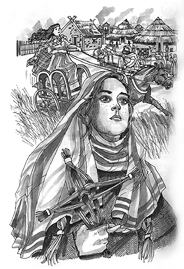The lives of saints
| Piety and devotion are essential qualities for a saint: one obviously doesn't qualify without them. But something a little more sensational is required to generate the kind of excitement that attracts an enthusiastic and enduring following.
 Saint Brigit from Celtic Heritage Saints
Saint Brigit from Celtic Heritage Saints
PHOTO: JEANNETTE DUNNE | |
English professor Dorothy Bray applauds the daring side of saints' natures when she characterizes them as "the medieval equivalent of comic book heroes."
Take her favourite story from the life of Saint Patrick. Desirous of taking Patrick into custody, the King sent a posse of men out to ambush him and his followers.
Fortuitously, Patrick learned of the plot in advance and prayed not to be captured. When they came upon the King's men, Patrick and his followers were miraculously transformed — Patrick into a stag, the others into a herd of deer — thereby evading arrest. His escape is at once testament to his faith in God, without which he never would have been spared, and a yarn of a magical exploit.
Patrick is but one of the more than 30 Irish saints from the seventh to 12th centuries whose lives Bray has spent the better part of a decade studying. She is engaged in an ambitious, one-woman project to construct a comprehensive catalogue of the folk motifs to be found in their legends.
This endeavour evolved from her PhD work, conducted at the University of Edinburgh.
The legends of the saints are replete with heroic derring-do, miraculous occurrences and astonishing wonder works. Bray, who serves as vice-president of the Celtic Studies Association of North America, says, "There are certain things a saint must do, certain conventions of the genre, many of which are drawn from Biblical tales and meant to set the saint as a follower of the example of Christ.
"You can learn a lot about what the people of the day considered important by studying the folklore of the saints," she adds. "Many of the deeds attributed to them are associated with people's immediate needs, such as healing or providing food or raising the dead."
Of course, piety played a central element, for this was the source from which their powers stemmed. Proof could be found in their surviving various trials.
One such trial put to Patrick saw him challenged to a showdown with the King's druids. One of the Saint's servants was placed in a dry hut, cloaked in a druid garment, while a druid servant was placed in a greenwood hut in one of Saint Patrick's robes. The two huts were then set ablaze.
Miraculously, it was Patrick's servant who survived, while the druid was consumed by flames.
That Saint Patrick is so widely celebrated owes much to the success of his hagiographers and the dispersion of Irish immigrants throughout the Western world who carried with them fealty to their patron saint.
Patrick attracted many early adherents because his success at proselytizing contributed to the wealth of churches attached to his name, such as that in Armagh. Later on, he attracted the attention of scholars because he is one of very few saints from that period to have actually left behind an autobiographical text.
However, Bray is interested in revealing the lives of the lesser-known saints, as well. Among her favourites is Saint Brigit.
One story she relates tells of how Brigit returned to a darkened hut after being out in the rain. Upon her arrival, a shaft of sunlight came through the ceiling into the hut.
She removed her drenched cloak and, finding no other place to hang it, proceeded to suspend it from the beam of light. Such a miraculous occurrence stands as evidence of her favour with God.
Bray's research involves carefully reading the lives of each of the saints and extracting from their stories the prevailing folkloric motifs. She then classifies them according to "A Motif-Index of Folk Literature" as devised by Stith Thompson, which is the standard system used by scholars of all manner of folklore. The completed database will provide an invaluable reference for scholars of Celtic studies and hagiography.

